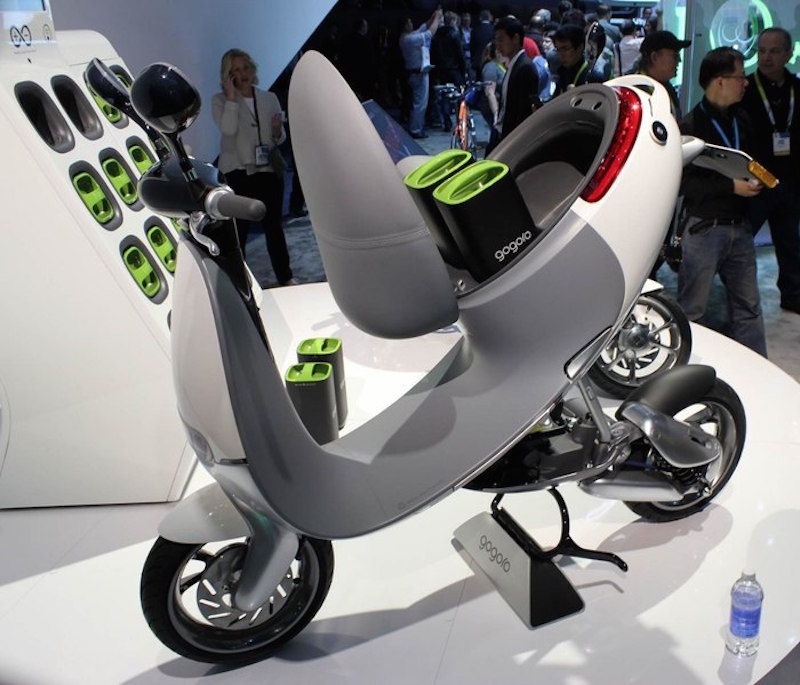The continued minituarization of electronics, advances in materials technology, a growing emphasis on clean, sustainable modes of transport and imaginative thinkers with out-of-the-box ideas have converged to give us some truly audacious vehicle designs over the past 12 months. Some are certainly more practical than others, but from personal tricopters to amphibious motorcycles this new breed of personal mobility solutions offers a tantalizing glimpse into how we might be getting from A to B in the future. As we head into a new year with new possibilities, let’s take a look at some that could have a role to play in shaping the future of transport.
The WalkCar electric rolling pad

Imagine an aluminum pad not much larger than your laptop that can be easily lugged around in your bag, and then when you encounter a stretch of smooth concrete you can whip it out and be zipped along at up to 10 km/h (6.2 mph). Granted that’s not a great deal faster than walking speed, but with a built-in battery, small footprint and four tiny wheels, the ultra-portable WalkCar from Japan’s Cocoa Motors shows what might be achieved with a less-is-more approach.
The world’s lightest electric skateboard


Electric skateboards came thick and fast in 2015. While different manufacturers have focused on different characteristics, be it power, all-terrain ability or range, one of the more important aspects is undeniably weight. A featherlight electric skateboard that weighs no more than an unpowered one might not be possible yet, but the Stary is the closest thing you’ll get at the moment. It weighs just 3.9 kg (8.6 lb), goes 16 km (10 mi) on each charge and can hit speeds of 30 km/h (18.6 mph).
From our partners:
The Gogoro battery-swapping Smartscooter


Brimming with 30 sensors and accompanied by a smartphone app where users can customize things like throttle control and regenerative braking, the electric Gogoro Smartscooter is impressive in itself. But there’s some big-picture thinking behind this particular urban vehicle. It cannot be charged via a wall outlet, rather it stays on the move through a network of battery exchange kiosks placed strategically around urban centers. In the year since debuting at CES in January, Gogoro has been successfully been trialed in Taiwan and then expanded into Europe. One to watch.
The auto-folding INU electric scooter


Another approach to electrical two-wheelers, the INU scooter counts on a smartphone-controlled folding system that packs the vehicle down into a transport-friendly, golf buggy-like form in just 4.5 seconds. We spied this funky little number at the Frankfurt Motor Show in October and though it is far from the only foldable scooter doing the rounds, its 40 km (25 mi) range, 25 km/h (15.5 mph) top speed and polished, user-friendly design make for a tastefully packaged commuting option.
All kinds of adventure squeezed into a single backpack

Those taking to the great outdoors are not safe from the clutches of transformative vehicle design either. The Klepper Backyak can be hoisted over the shoulder when en route to a range of adventurous activities and be converted into a kayak, sailboat, snow sled or floating sun deck when you reach your destination. Now that’s versatility.

A motorcycle you can ride straight into a lake and out again

What do you get when you combine a 55-horsepower motorcycle and a small jet ski in the one machine? Probably a whole lot of fun. The Biski from serial amphibious vehicle maker Alan Gibbs can hit speeds of 129 km/h (80 mph) on land and then when you roll up to shore, switch to jet ski mode in around five seconds to bound across the water at up to 60 km/h (37 mph).

A jetpack you could buy and fly now (well, technically)

Our collective pursuit of personal, backpack-powered flight received a nice little nudge in November, when aviator David Mayman circled the Statue of Liberty in his JB-9 jetpack. It burns through fuel at around a gallon (3.8 L) a minute to offer a flight time of over 10 minutes, and though Mayman says he has had multi-million dollar offers for the jetpack and could technically start selling a modified version in the ultralight category tomorrow, he feels a certain responsibility about where it might take overenthusiastic pilots.

“I’d wanna feel like we have an infrastructure to train them,” Mayman told us last month. “We could technically just send them the unit in a box and say ‘good luck’ but it’s not necessarily going to end well if you’re doing 200 km/h (124 mph), 5 feet (1.5 m) off the ground, you know? It could be a monster. But we’re working on it. We’ll get there.”
So the wait continues, but it appears there’s a light at the end of the tunnel.
A flying bicycle


Just like the maker of the JB-9, the a team of Hungarian researchers are looking to the skies to usher in a new form of transport. Its Flike tricopter is designed to allow 15 to 20 minutes of hover flight or 30 to 40 minutes of cruise flight. In manned testing back in May, the team took an important step forward demonstrating the vehicle’s ability to hover, perform maneuvers and compensate for wind. Though a market-ready tricopter is still a ways off, the team is buoyed by its early success and is now working towards a second prototype that will feature similar capabilities to that of its planned commercial model.
Where to from here?
So there you have it, a look at some of the more eye-catching developments in transport to cross our desks over the past year. Some can be ordered now, some may be available soon and some may just continue to tease us (we’re looking at you, jetpack). But all of these demonstrate an imaginative approach to moving people around and with that, contribute to progress in their own way. What will that mean for 2016? Perhaps an affordable, functioning hoverboard? A working Hyperloop?
This feature originally appeared in GizMag.

















